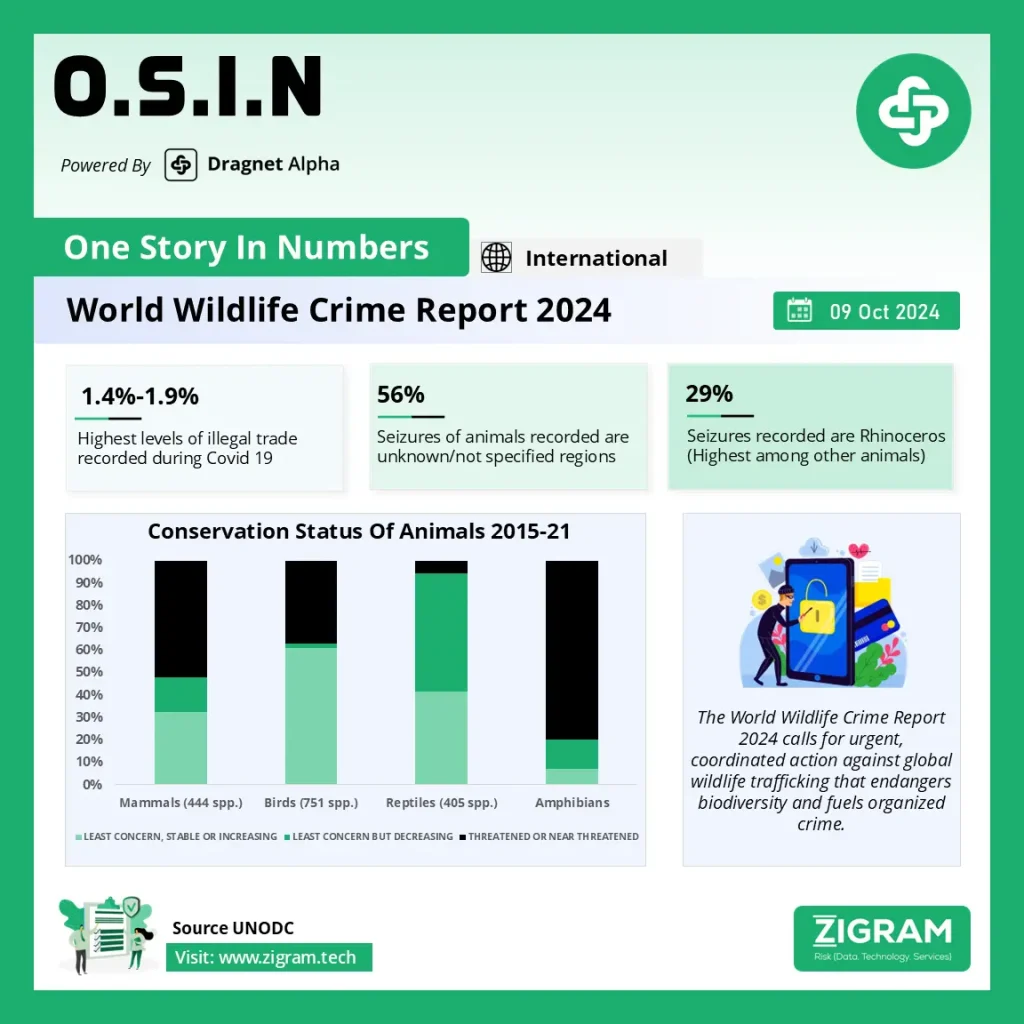World Wildlife Crime Report
The World Wildlife Crime Report 2024, published by the United Nations Office on Drugs and Crime (UNODC), examines global trends, impacts, and responses to the trafficking of protected species. With the report’s emphasis on evidence-based analysis, this third edition reveals insights into wildlife trafficking’s scale and complexity, evaluates current intervention effectiveness, and underscores areas requiring greater focus to curb this illicit trade.
Overview And Scope
Wildlife trafficking remains pervasive worldwide, affecting over 4,000 plant and animal species and involving 162 countries and territories. Despite global initiatives, including Sustainable Development Goal (SDG) target 15.7 to end trafficking, progress remains insufficient. The report reveals an alarming increase in intercepted illegal wildlife trade, with recorded seizures of trafficked goods peaking during the COVID-19 pandemic. The persistence of this crime highlights a need for robust international responses.
Key Findings And Impact Areas
1. The Global Wildlife Trafficking Landscape
Wildlife trafficking’s sheer magnitude impacts multiple environmental, social, and economic spheres, as the report outlines:
a) Species Impact: Trafficking disproportionately affects iconic species like elephants and rhinoceroses, but less-known species, such as orchids, turtles, and exotic birds, also face extinction risks.
b) Ecological Harm: The illegal removal of species disrupts ecosystems and exacerbates climate change, as natural ecosystems help stabilize global climates.
c) Socioeconomic Consequences: Trafficking jeopardizes local communities dependent on wildlife-related income and risks diminishing employment in wildlife-based industries.
2. Organized Crime and Corruption
Organized criminal groups have become significant players in wildlife trafficking. They exploit weak regulation, facilitate poaching, and take advantage of vulnerable local communities. The report notes:
a) Adaptability: Criminal groups continuously alter trafficking routes and methods to circumvent regulations, and they exploit emerging market trends for greater profit.
b) Corruption: Corruption is prevalent across trafficking stages, with bribes frequently exchanged to facilitate illicit trade. Despite this, cases involving wildlife trafficking rarely invoke anti-corruption laws, which might offer stricter penalties.
3. Impacts on Conservation and Biodiversity
The environmental toll of wildlife trafficking is substantial. Species overexploitation disrupts ecosystems, with trafficking often leading to cascading effects across biodiversity and even endangering broader ecological health:
a) Conservation Risks: Beyond famous species, trafficking in less-publicized flora, like rare succulents and orchids, contributes significantly to biodiversity loss.
b) Climate Interdependence:The loss of species destabilizes ecosystems that are crucial for climate regulation, adding further urgency to addressing trafficking.
4. Socioeconomic and Community Impacts
Wildlife trafficking weakens governance, as it erodes legal frameworks, and creates financial and operational burdens on governments:
a) Income and Livelihoods: Trafficking undermines income from wildlife-based economies, deprives communities of essential goods, and affects food and water security.
b) Governance:Corruption associated with trafficking disrupts governance, with illegal activities siphoning resources and reducing public trust in authorities.
Drivers And Mechanisms Of Wildlife Crime
The report outlines multifaceted motivations behind wildlife crime, including financial incentives, poverty, and organized crime dynamics, highlighting several crucial elements:
Financial Gain: Profit remains the primary driver, with traffickers pursuing markets for luxury items, traditional medicine, and exotic pets.
Opportunistic Participants: Many involved in wildlife crime are local actors seeking basic income, especially in regions with limited economic opportunities.
Market Dynamics: Demand for rare items propels trafficking, as scarcity increases an item’s appeal and value. The report documents how traffickers sometimes manipulate consumer trends to boost demand.
Effective Interventions And Policy Recommendations
The UNODC report emphasizes the importance of targeted interventions to counter wildlife trafficking effectively. Successful measures should address both supply and demand dynamics through coherent and harmonized policies across jurisdictions.
Policy And Practical Recommendations
1. Strengthen Enforcement and International Collaboration
– Develop cross-border collaborations to monitor trafficking routes and improve intelligence sharing.
– Harmonize legal frameworks to remove gaps that traffickers exploit, such as different legal standards across countries.
2. Target Corruption
– Enforce corruption laws in trafficking cases, focusing on officials involved in licensing and inspection processes.
-Implement sector-specific anti-corruption strategies to mitigate risks in areas prone to wildlife crime.
3. Empower Local Communities
– Provide incentives for community involvement in wildlife conservation and create alternative livelihood opportunities to reduce poaching reliance.
– Address human-wildlife conflict, particularly in regions where animals threaten crops and livestock.
4. Increase Evidence-Based Interventions
– Collect and analyze data to understand trafficking patterns, price changes, and trafficking impact on species populations.
– Fund long-term research to gauge intervention effectiveness, shifting focus from arrest and seizure rates to more holistic impacts on wildlife populations and ecosystems.
5. Utilize Emerging Technologies
– Apply digital tracking systems to monitor endangered species and high-value commodities.
– Leverage machine learning to predict trafficking patterns and focus law enforcement efforts where they are most needed.
Conclusion And Future Directions
The World Wildlife Crime Report 2024 advocates a unified, scientifically informed approach to combatting wildlife trafficking. While there are some indications of progress—particularly in high-profile cases involving elephant ivory and rhinoceros horns—broader success hinges on sustained, multifaceted interventions. By addressing the crime holistically—incorporating environmental, social, and economic considerations into strategic planning—stakeholders can help ensure that efforts to reduce wildlife trafficking will ultimately support species conservation, ecosystem stability, and the well-being of communities worldwide.
Click here to know more.
Please read about our product: Dragnet Alpha
Click here to book a free demo
- #WildlifeCrimeReport
- #EndWildlifeTrafficking
- #BiodiversityConservation
- #OrganizedCrime
- #UNODC
- #ProtectEndangeredSpecies
- #WildlifeProtection
- #SustainableEcosystems
- #FightWildlifeTrafficking
- #GlobalConservationEfforts
